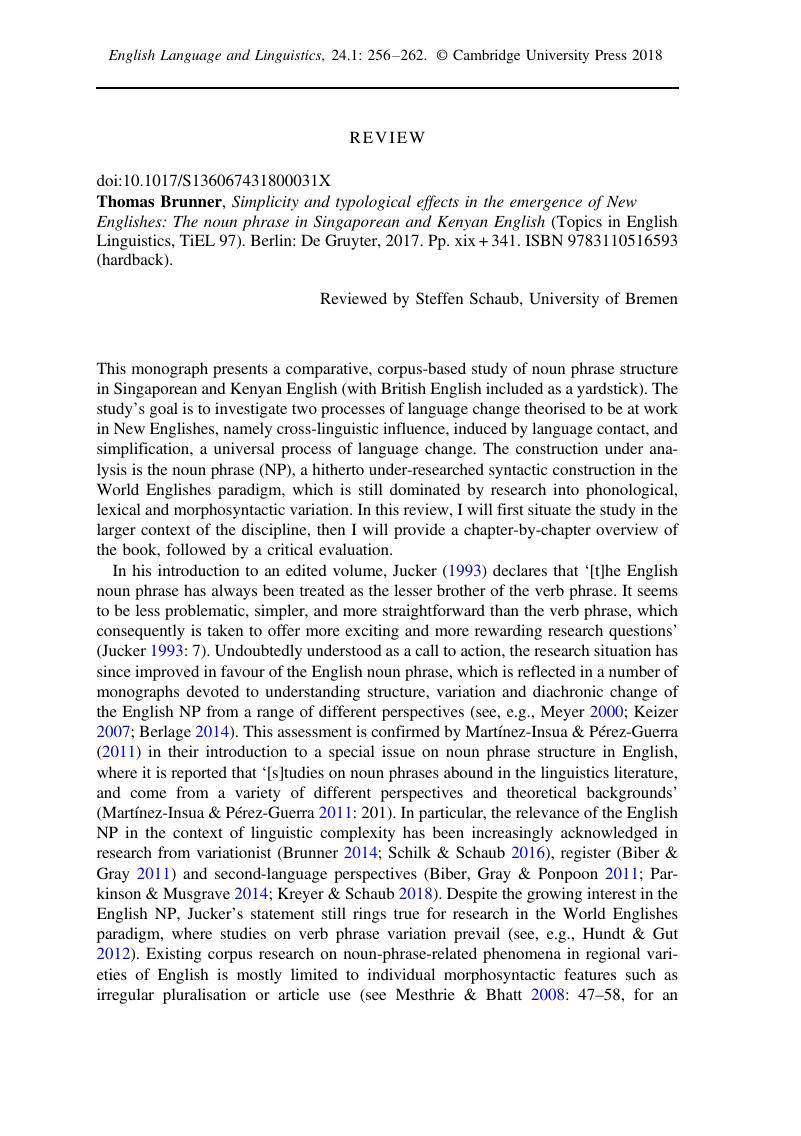No CrossRef data available.
Article contents
Thomas Brunner, Simplicity and typological effects in the emergence of New Englishes: The noun phrase in Singaporean and Kenyan English (Topics in English Linguistics, TiEL 97). Berlin: De Gruyter, 2017. Pp. xix+341. ISBN 9783110516593 (hardback).
Published online by Cambridge University Press: 21 December 2018
Abstract
An abstract is not available for this content so a preview has been provided. Please use the Get access link above for information on how to access this content.

- Type
- Book Review
- Information
- Copyright
- Copyright © Cambridge University Press 2018
References
Akinlotan, Mayowa. 2018. A corpus-based study of the structure of the noun phrase in Nigerian English. Unpublished PhD thesis, Vrije Universiteit Brussels.Google Scholar
Bache, Carl. 2000. Essentials of mastering English: A concise grammar. Berlin: De Gruyter.CrossRefGoogle Scholar
Berlage, Eva. 2014. Noun phrase complexity in English. Cambridge: Cambridge University Press.CrossRefGoogle Scholar
Biber, Douglas & Gray, Bethany. 2011. Grammatical change in the noun phrase: The influence of written language use. English Language and Linguistics 15(2), 223–250.CrossRefGoogle Scholar
Biber, Douglas, Gray, Bethany & Poonpon., Kornwipa 2011. Should we use characteristics of conversation to measure grammatical complexity in L2 writing development? TESOL Quarterly 45(1), 5–35.CrossRefGoogle Scholar
Brunner, Thomas. 2014. Structural nativization, typology and complexity: Noun phrase structures in British, Kenyan and Singaporean English. English Language and Linguistics 18(1), 23–48.CrossRefGoogle Scholar
Hundt, Marianne & Gut, Ulrike. 2012. Mapping unity and diversity world-wide: Corpus-based studies of New Englishes. Amsterdam: John Benjamins.CrossRefGoogle Scholar
Jucker, Andreas H. (ed.). 1993. The noun phrase in English: Its structure and variability. Heidelberg: Winter.Google Scholar
Keizer, Evelien. 2007. The English noun phrase: The nature of linguistic categorization. Cambridge: Cambridge University Press.CrossRefGoogle Scholar
Kreyer, Rolf & Schaub, Steffen. 2018. The development of phrasal complexity in German intermediate learners of English. International Journal of Learner Corpus Research 4(1), 82–111.CrossRefGoogle Scholar
Martínez-Insua, Ana E. & Pérez-Guerra, Javier. 2011. An open-sesame approach to English noun phrases: Defining the NP (with an introduction to the special issue). English Language and Linguistics 15(2), 201–221.CrossRefGoogle Scholar
Mesthrie, Rajend & Bhatt, Rakesh M.. 2008. World Englishes: The study of new linguistic varieties. Cambridge: Cambridge University Press.CrossRefGoogle Scholar
Meyer, Matthias L. G. 2000. Determination in der englischen Nominalphrase: Eine korpuslinguistische Studie. Heidelberg: Winter.Google Scholar
Parkinson, Jean & Musgrave, Jill. 2014. Development of noun phrase complexity in the writing of English for Academic Purposes students. Journal of English for Academic Purposes 14, 48–59.CrossRefGoogle Scholar
Schaub, Steffen. 2016. The influence of register on noun phrase complexity in varieties of English. In Christoph Schubert & Christina Sanchez-Stockhammer (eds.), Variational text linguistics: Revisiting register in English, 251–270. Berlin: De Gruyter.Google Scholar
Schilk, Marco & Schaub, Steffen. 2016. Noun phrase complexity across varieties of English. English World-Wide 37(1), 58–85.CrossRefGoogle Scholar
Schneider, Edgar W. 2007. Postcolonial English: Varieties around the world. Cambridge: Cambridge University Press.CrossRefGoogle Scholar
Szmrecsanyi, Benedikt, Grafmiller, Jason, Heller, Benedikt & Röthlisberger, Melanie. 2016. Around the world in three alternations: Modelling syntactic variation in varieties of English. English World-Wide 37(2), 109–137.CrossRefGoogle Scholar
Tan, Siew I. 2013. Malaysian English: Language contact and change. Frankfurt: Peter Lang.CrossRefGoogle Scholar


